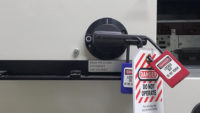During the past 25 years, I’ve looked at hundreds of energy control programs. Common problems pop up everywhere and include both violations of OSHA standard 29 CFR 1910.147 and internal procedures. The 10 most common problems with lockout/tagout processes are:
1. Lack of procedures
Specific procedures should be written for each piece of equipment or process that identify all energy sources and the energy isolation devices. The procedure becomes the checklist to assure that all energy sources are controlled before servicing and maintenance starts. (Note: OSHA requires a specific written procedure when a single lockout device will not achieve zero energy state. See 29 CFR 1910.147(c)(4).)2. Training all employees
Most employers do a good job of training those employees who apply locks and tags (called “authorized employees”) and those who operate the machines where locks and tags are installed (called “affected employees”). But OSHA requires awareness training for a category of employees called “all other employees.” These employees usually include management and staff who have occasion to walk around equipment that is locked and tagged, but they do not actually operate, service or maintain the equipment. “All other employees” must be apprised of the purpose of lockout/tagout, the energy control devices used, and to leave the locks and tags alone. (See 29 CFR 1910.147 (c)(7)(I)(C).)3. Wrong use of tags
Energy control tags are sometimes used as information tags or process control tags. The only use for your “Danger Do Not Operate” energy control tag is for servicing and maintenance of equipment. Any other use degrades the importance of the tag. Most facilities need at least four different tags: (See 29 CFR 1910.147 (c)(5)(ii).)- Energy control for servicing and maintenance
- Process control for production purposes
- Informational to impart information
- “Danger Do Not Use” for defective tools and equipment
4. Wrong use of locks
Lockout locks are sometimes used for tool boxes and lockers. As above, the energy control lock’s only purpose is for energy control during servicing and maintenance. Every employee must respect the hazardous energy control lock. (See 29 CFR 1910.147(c)(5)(ii).)5. Working under someone else's lock
OSHA’s standard and best practices require each employee servicing a piece of equipment to apply his or her own lock and tag for personal energy control responsibility. (Note that OSHA Instruction STD 1-7.3 does allow sign-in/sign-out in lieu of personal locks.) Some employers mistakenly require only the crew chief or journeyman to apply a lock and tag for a crew or gang. No individual should take responsibility for the safety of another worker where lockout/tagout is necessary. (See 29 CFR1910.147(d).)6. Not identifying all energy sources
Opening a disconnect by itself does not always control all hazardous energy. Sometimes overlooked are separate circuits running to a machine, delivery of energy from an overhead crane or adjacent conveyor, and gravity and kinetic energy. The written procedure must identify all energy sources. (See 29 CFR1910.147(b) and (c)(4).)7. Annual audit of procedures and review of findings
OSHA requires an annual audit of each procedure and a review of the audit findings with each authorized employee where lockout is used, and each authorized and affected employee where only tagout is used. The audit should determine if all energy sources have been identified, if employees understand which energy source is harmful and which is not (such as water pipes and low voltage), and if the energy control procedures are understood and followed. (See 29 CFR1910.147(c)(6).)8. Maintenance vs. minor routine tool changes
Do your employees de-energize and lock out when they change a light bulb, change a drill bit, change a grinding stone, change the speed of the belt on the drill press, or stand up an overturned bottle on a conveyor line? They need to know the difference in servicing and maintenance versus minor, routine adjustments and normal production operations. When they don’t know, employees don’t usually take the initiative to lock out “just in case.” (See 29 CFR1919.147(a)(2).)9. Oversight
During the hundreds of lockout/tagout audits that I’ve done, it’s fairly easy to find deficiencies. But too many managers and safety professionals assume that their energy control policies work just fine. Probing questions and some healthy skepticism should be part of any energy control program review.10. Duplicate keys
OSHA took a position in a letter to Honeywell that duplicate keys should not be on hand to remove locks. This makes lock removal too easy when an employee who applied the lock has left the facility. Destroy those duplicate keys and use bolt cutters to make someone think twice and follow the proper procedures to remove a lock.A survey among our clients last year indicated that lockout/tagout was the number one most important safety procedure. Don’t let your system fail.

